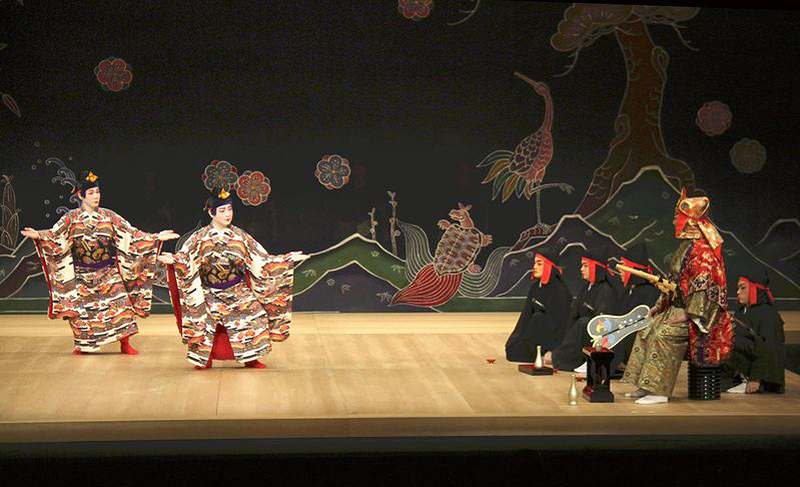
A scene from a Kumi-odori drama titled “Nido Tekiuchi,” a story of two sons on a mission of revenge, on Feb. 12 at the National Theatre Okinawa in Urasoe, Okinawa Prefecture.
11:37 JST, March 11, 2022
Okinawa features its own history and culture, and the performing arts are no exception. Kumi-odori, a singing and dancing drama with a 300-year tradition, was the stage musical of its time and survived the hardships through the years as a sign of the resilience of Okinawa entertainment culture.
Kumi-odori was first performed at Shuri Castle in 1719 to entertain an envoy from the Qing dynasty emperor of China to the Ryukyu Kingdom, which ruled the region that included what is now Okinawa Prefecture from 1429 to 1879.
Performers clad in brightly dyed costumes danced elegantly and sang lyrics in the language of the era, accompanied by music from a sanshin, the three-stringed instrument covered with snake skin that is a feature of Okinawa. It was an amalgamation of the best of Ryukyu culture.
After the Ryukyu Kingdom ceased to exist in 1879 with the incorporation of Okinawa as a prefecture of Japan, kumi-odori moved out of the royal court and into common society. It would later serve to lift the spirits of the people in the aftermath of the devastating Battle of Okinawa in World War II.
In December 1945, a performance was held in the schoolyard of an elementary school titled “Hanauri no En,” a story of family members separated being reunited. Over 5,000 attended and many, who were going through that very experience, were moved to tears.
“As kumi-odori overcame hardship along with the people, it became the pride of Okinawa,” said Michihiko Kakazu, 42, artistic director of the National Theatre Okinawa located in Urasoe.
On May 15, 1972, the day that Okinawa was returned to Japan sovereignty, kumi-odori received designation as an important intangible cultural asset by the central government, which filled the performers with confidence and pride.
“With that, I became a Japanese citizen just like any person on the main island,” said Noho Miyagi, 83, a kumi-odori performer who has been designated as a living national treasure. “As kumi-odori was recognized as a traditional ‘Japanese’ art form, I felt a stronger need to do my best to keep the tradition going.”
The National Theatre Okinawa opened in 2004, staging regular performances of Ryukyu performing arts. It also started a project to train a new generation of performers and musicians to pass on the traditions. So far, 48 people have completed the three-year program; among the first was Shinji Kinjo, 34, who will take over as artistic director of the theater in April.
Getting the word out
In 2010, kumi-odori was registered on the list of UNESCO intangible cultural heritages. Even so, there are only about 20 performances per year at the theater, a number far smaller than that of kabuki, which is performed almost daily at the Kabukiza in Tokyo and other theaters.
To address a need to make kumi-odori more well known, in January this year the National Theatre Okinawa began to stream videos of kumi-odori and other traditional dances online for a fee. At the Tokyo National Museum, kumi-odori costumes are on display as part of an exhibit on traditional Japanese arts that will last through Sunday.
Kumi-odori mainly involves classic stories along the theme of loyalty and filial piety, but there are calls to come up with new story lines. Performing such pieces repeatedly will also produce stars with their own followers, like those in kabuki, which will draw more young people to the theater.
Even following the fire that destroyed Okinawa’s beloved Shuri Castle, kumi-odori performers continued a national tour, and were showered with generous applause at every stop.
By sharing the history and appeal of Ryukyu performing arts, the hope is that it will lead to mutual understanding between Okinawa and the rest of Japan.
"Culture" POPULAR ARTICLE
-

Van Cleef & Arpels Dazzles with Art Deco Artisanry at Tokyo Exhibit
-

Disney’s ‘Twisted-Wonderland’ Animated Series Puts Villains in Spotlight: New Show Features School Inspired by Classic Disney Films
-

Japan Plans to Distribute Manga Overseas Via New Platform
-

Ayumi Hamasaki’s Shanghai Concert Canceled Day Before Schedule as Part of Beijing Backlash
-

‘The World Masterpiece Theater Series’ Celebrates 50 Years; Animator Looks Back on Creating Anime Classics
JN ACCESS RANKING
-

Keidanren Chairman Yoshinobu Tsutsui Visits Kashiwazaki-Kariwa Nuclear Power Plant; Inspects New Emergency Safety System
-

Imports of Rare Earths from China Facing Delays, May Be Caused by Deterioration of Japan-China Relations
-

University of Tokyo Professor Discusses Japanese Economic Security in Interview Ahead of Forum
-

Japan Pulls out of Vietnam Nuclear Project, Complicating Hanoi’s Power Plans
-

Govt Aims to Expand NISA Program Lineup, Abolish Age Restriction






















